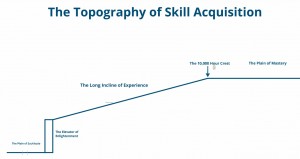 In Part 2 of this series, I formally introduced my Topography of Skill Acquisition. It is comprised of five distinct parts, which I described in the following posts:
In Part 2 of this series, I formally introduced my Topography of Skill Acquisition. It is comprised of five distinct parts, which I described in the following posts:
- Part 3: The Plain of Suckitude — “When acquiring a new skill, everyone begins on this plain. It is flat, since when you are on the plain you have the distinct impression that you are not gaining any altitude. You can’t do the skill well, if at all. You don’t quite understand it yet. You fail time and again. If you are trying to sew, you stick your finger with the needle. If you are trying to learn how to ride a bike, you fall. If you are trying to ski, you crash. Repeatedly, and sometimes spectacularly. In a word, you suck. And worse, you know it and you know that everyone around you knows it.”
- Part 4: The Elevator of Enlightenment — ” When you arrive at the “ah ha!” moment of a new skill, it is when muscle memory takes over, or when the mental grooves are finally deep enough that you suddenly “get it”. Suddenly, you aren’t falling, or dropping a stitch, or smashing your finger with the hammer. You have reached the Elevator of Enlightenment.”
- Part 5: The Long Incline of Experience — “…the Elevator of Enlightenment saves you from the Plain of Suckitude, and dumps you out on the Long Incline of Experience. For most people, this is where you will camp. This means it is a skill that you will always have, but that you will never truly become an expert.”
- Part 6: The 10,000 Hour Crest — “…as has been popularized by Malcolm Gladwell in the book Outliers: The Story of Success, it takes quite a bit of work [to truly master a skill]. About 10,000 hours, to be exact.”
- Part 7: The Plain of Mastery — “…if you have reached the 10,000 Hour Crest for any given skill you can count yourself among the few masters of it. And that is also when you find yourself on the Plain of Mastery. Far, far, from the Plain of Suckitude, here is where you can rest in the knowledge that there are few who can match your mastery. Can you still improve? Probably, in minor kinds of ways. Do you need to? That’s up to you. The point is you don’t have to.”
Up Next: Being Different, Part 9: How Not to Die on the Plain of Suckitude

